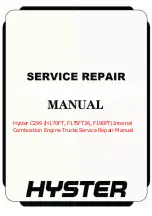
A - During use
●
Before loosening the pipe fittings or hoses,
the truck must be switched off and the bot-
tle tap must be closed. The closure nuts on
the bottles should be loosened slowly and
only partially at first, otherwise the gas un-
der pressure in the piping may escape vio-
lently.
CAUTION
Possible injury from frostbite!
Liquid gas in contact with the skin causes freeze
burns!
●
When a removable gas bottle (i.e., cylin-
ders) is installed, it must be assembled onto
the truck in a horizontal position with the
threaded fitting of the tap facing down-
wards. During assembly and disassembly,
close the tap with the respective threaded
plug (supplied with the bottle). Before con-
necting the gas bottle, check that the fittings
are compatible with the pipe. After disas-
sembly of the empty bottle, the threaded
plug (supplied with the bottle) should be
screwed back on.
●
The tap must be opened slowly! The open-
ing and closing of the tap must be carried
out without the aid of any tools in order to
avoid the risk of explosions due to sparks.
CAUTION
In case of fires involving liquid gas, only dry or gas-
eous carbon dioxide fire extinguishers should be
used!
●
Gas bottles which are not leak-tight must
not be used, but should instead be immedi-
ately emptied outdoors, taking all the nec-
essary safety precautions, and then marked
with the legend "DEFECTIVE". If damaged
bottles have been supplied, immediately no-
tify the distributor or its representative (deal-
er, etc.) of the damage, in writing if possi-
ble. In any event, never use a damaged
bottle.
●
The entire liquid gas system must be
checked frequently to ensure that it works
safely, paying particularly attention to the
tightness of all its parts. It is prohibited to
use the truck when the liquid gas system is
not airtight. To check the tightness of the
system, use soapy water, Nekal solution or
other foaming agents. It is prohibited to in-
spect the liquid gas system with an open
flame.
●
Ensure that the engine is adjusted so as to
produce only a minimum quantity of noxious
gases in the exhaust.
●
Frozen parts of the system must be thawed
out only with hot water, hot sandbags or the
like. Open flames, incandescent objects etc.
may cause explosions.
●
When any single part of the system is being
replaced, the manufacturer's installation in-
structions must be followed. The tap of the
bottle must be closed during these opera-
tions.
●
The conditions of the electrical systems of
liquid gas-powered trucks should be moni-
tored constantly. In case of leaks in the gas-
conducting parts of the system, sparks from
the electrical components may cause explo-
sions. After a liquid gas-powered truck has
been shut down for a lengthy period, the
garage must be thoroughly aerated before
starting up the truck or its electrical system.
●
Trucks with LPG engines must only be used
in closed or partially closed areas once it
has been guaranteed that the area in ques-
tion is sufficiently well-ventilated. This pre-
caution prevents the accumulation of dan-
gerous concentrations of harmful gases.
●
Liquid gas-powered fork lift trucks may be
parked only in well-ventilated garages
which are not underground. They must not
be parked near cellar entrances or ditches
or similar cavities, or near openings of
drainage canals or open sewers, near air
shafts, stairwells or places where flamma-
ble materials are stored.
●
During work in the repair shops, the tap of
the bottle must be closed and the gas bot-
tles should be protected against heat. Work
requiring the use of a flame, particularly for
welding or cutting, must not be carried out
near gas bottles. Gas bottles, even when
empty, must not be stored in the shops.
●
In case of explosions, even if no accidents
have been caused, inform the relevant au-
thorities in compliance with the current re-
quirements in the country in which the truck
is used.
●
The replacement of gas containers (replac-
ing empty bottles with full bottles) is allowed
Safety
2
General safety rules for liquid gas
19
60118011601 EN - 09/2020
Summary of Contents for RCG40
Page 1: ...LPG forklift truck RCG40 RCG50 Original instructions 4234 4236 60118011601 EN 09 2020 ...
Page 2: ......
Page 4: ......
Page 10: ......
Page 11: ...1 Introduction ...
Page 19: ...2 Safety ...
Page 41: ...3 Information about the truck ...
Page 52: ...Information about the truck 3 Location of the decals 42 60118011601 EN 09 2020 ...
Page 53: ...4 Use and Operation ...
Page 123: ...5 Maintenance ...
Page 159: ...6 Technical datasheet ...
Page 160: ...Dimensions Technical datasheet 6 Dimensions 150 60118011601 EN 09 2020 ...
Page 170: ......
Page 171: ......
Page 172: ...STILL GmbH 60118011601 EN 09 2020 ...
Page 173: ...LPG forklift truck RCG40 RCG50 Original instructions 4234 4236 60118011601 EN 09 2020 ...
Page 174: ......
Page 175: ...7 Diagrams ...
Page 177: ...Hydraulic diagram Diagrams 7 Hydraulic diagram 167 60118011601 EN 09 2020 ...
Page 178: ...Diagrams 7 Hydraulic diagram 168 60118011601 EN 09 2020 ...
Page 179: ......
Page 180: ...STILL GmbH 60118011601 EN 09 2020 ...





































